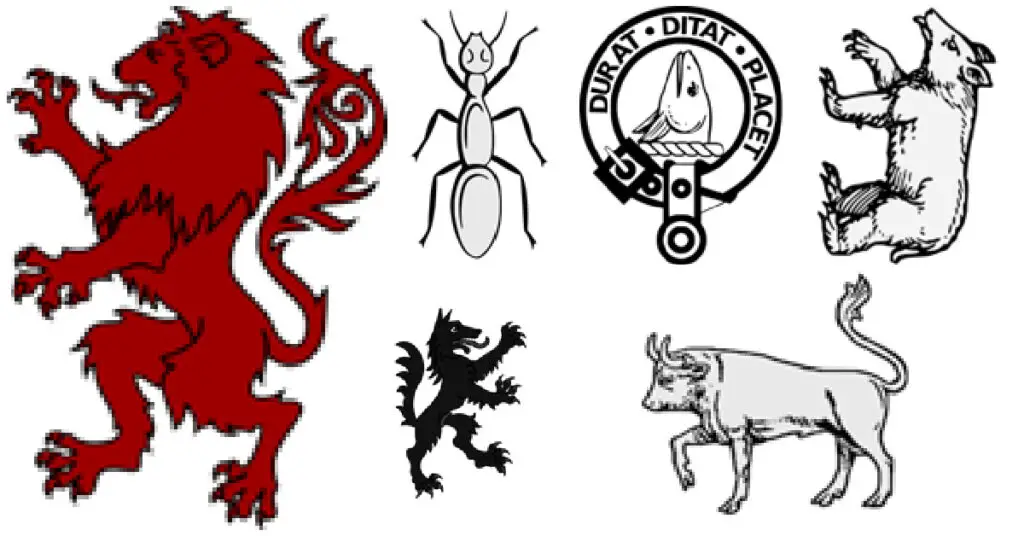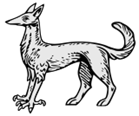Throughout history, important families, institutions, and governments have used the symbology to represent themselves. In medieval times, European feudal dynasties frequently adopted complex symbols as a way of adding prestige and personality to their rule.

It was particularly common for royal families to use images of animals to represent their dynasty or the culture and history of their country. Here are some of the more prominent heraldic royal symbols from medieval European iconography.
Lion
Courage, nobility, royalty, strength, and valor.
Possibly the most common animal depicted in heraldry, the lion represents courage, nobility, royalty, strength, and valor. The lion also has connections to Christianity through myths such as the lion of Judah or Daniel in the lion’s den.

Emmet Symbol
The emmet, or heraldic ant, is also a fairly common charge in European heraldry. The emmet is typically associated with hard work. It is also occasionally referred to as the pismire.

Enfield
The Enfield is a fictional animal with the head of a fox, the talons of an eagle, and the body of a lion. It is also occasionally depicted with the hindquarters of a wolf, as well as with wings.
The Enfield makes its earliest historical appearance on the coat of arms of the Ó Cellaigh family of Ireland, today transliterated as O’Kelly.

Ged Symbol
The term “Ged” refers to the heraldic form of the pike (also known as the pickerel or esox). The Ged is an example of a charge used frequently in “canting” heraldry. That is, a form of symbolism used to make a pun or play on words using the name of the family is represented. Pictured is the crest badge of the Scottish Clan Ged.
The pike also appears on the coat of arms for several Norman families named “de Lucy”, since another word for “pike” in English is “luce”.

Wolf Symbol
Although wolves have often been regarded as savage beasts throughout European history, they have also been associated with nobility and courage. Accordingly, the wolf appears frequently in European heraldry. The wolf has been used by a number of European families and locales in their coat of arms, including multiple municipalities in Finland, as well as the Salazar family of Navarre.

Bear Symbol
Although bears do not appear as frequently in European heraldry as other beasts such as lions or wolves, they are still used from time to time. Like the GED, bears appear frequently as canting arms, being used in the coats of arms for the Barnard, Baring, Barnes, and Bearsley families.
Bears are sometimes depicted with their mouths muzzled, typically for areas that lack wild bears, such as Ireland

Bull symbol
Bulls appear on the coats of arms for a number of British noble families, as well as organizations like the Worshipful Company of Butchers.
The bull typically represents fecundity, protection, sacrifice, patience, and perseverance. They have been used in mythological and other iconography since ancient times.

Deer Royal Symbol
According to heraldic scholars, deer are used in heraldry to represent peace, harmony, and coexistence. Deers are typically not hostile unless provoked by others, and this is reflected in their use as a heraldic charge.
The deer notably appears as heraldic support on the coat of arms for Baden-Wurttemberg, formed after the merger between Wurttemberg-Baden and Wurttemberg-Hohenzollern.
Swine Royal Symbol
Pigs, boars, and other suidae have been used in European iconography since well before the establishment of classical heraldry. It was used as the emblem of multiple Roman legions during the age of the Roman Empire, and it’s popularity as a symbol continued through medieval times.
The swine is typically used to represent aggression and combat.
Horse Royal Symbol
Horses were very important to the expression of military power, communication, and travel throughout human history. Accordingly, horses in heraldry typically represent a readiness for battle and a major backbone of organized civilization.
Horses appear in the coats of arms for Angomont, Apfingen, the 2nd Field Artillery Regiment of the Spanish Army, and Lithuania.
